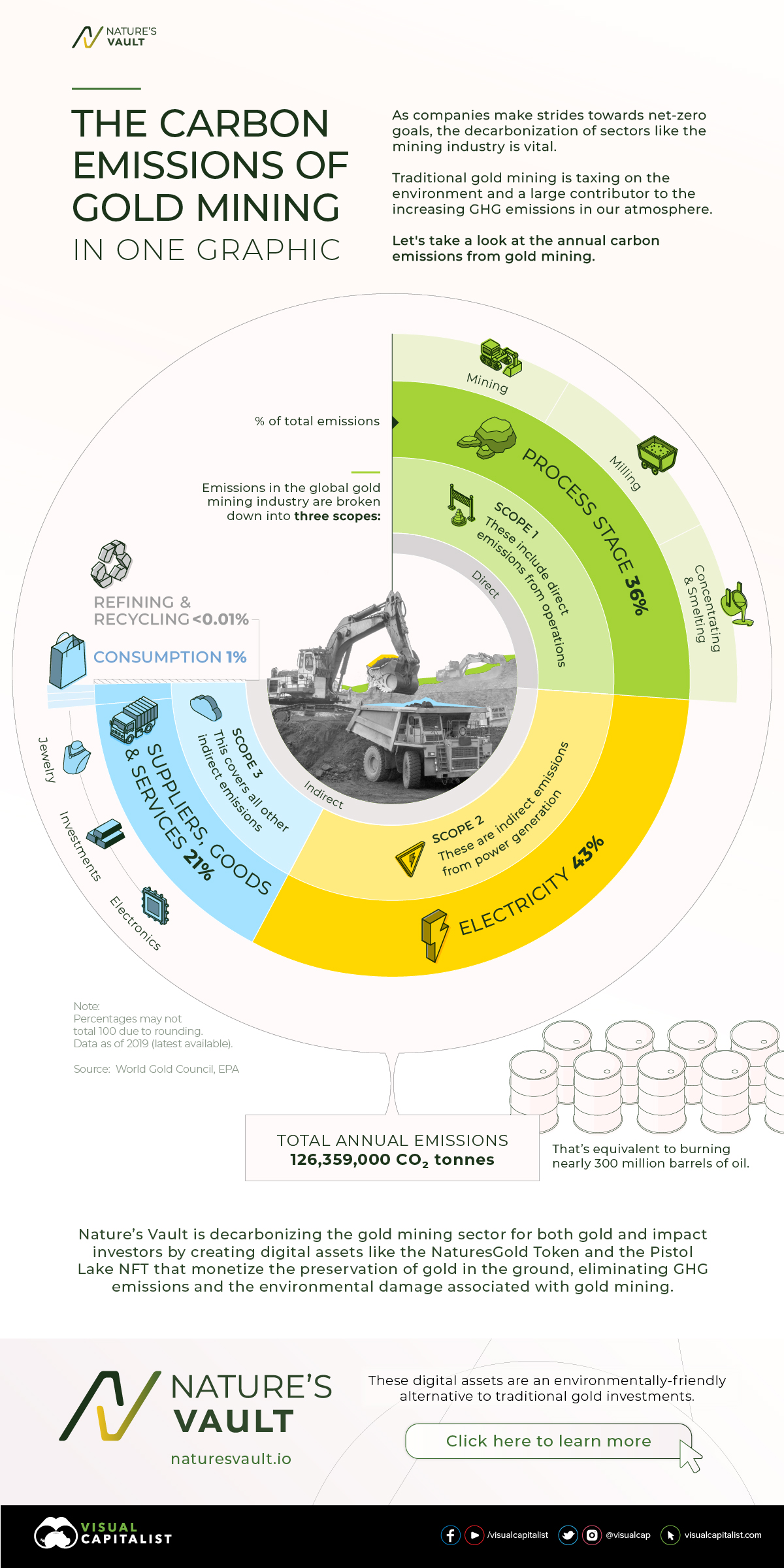The Carbon Emissions of Gold Mining

The Carbon Emissions of Gold Mining
As companies progress towards net-zero goals, decarbonizing all sectors, including mining, has become a vital need.
Gold has a long history as a valuable metal due to its rarity, durability, and universal acceptance as a store of value. However, traditional gold mining is a process that is taxing on the environment and a major contributor to the increasing carbon emissions in our atmosphere.
The above infographic from our sponsor Nature’s Vault provides an overview of the global carbon footprint of gold mining.
The Price of Gold
To understand more about the carbon emissions that gold mining contributes to, we need to understand the different scopes that all emissions fall under.
In the mining industry, these are divided into three scopes.
- Scope 1: These include direct emissions from operations.
- Scope 2: These are indirect emissions from power generation.
- Scope 3: These cover all other indirect emissions.
With this in mind, let’s break down annual emissions in CO2e tonnes using data from the World Gold Council as of 2019. Note that total emissions are rounded to the nearest 1,000.
| Scope | Type | CO2e tonnes |
|---|---|---|
| 1 | Mining, milling, concentrating and smelting | 45,490,000 |
| 2 | Electricity | 54,914,000 |
| 3 | Suppliers, goods, and services | 25,118,000 |
| 1,2,3 | Recycled Gold | 4,200 |
| 3 | Jewelry | 828,000 |
| 3 | Investment | 4,500 |
| 3 | Electronics | 168 |
| TOTAL | 126,359,000 |
Total annual emissions reach around 126,359,000 CO2e tonnes. To put this in perspective, that means that one year’s worth of gold mining is equivalent to burning nearly 300 million barrels of oil.
Gold in Nature’s Vault
A significant portion of gold’s downstream use is either for private investment or placed in banks. In other words, a large amount of gold is mined, milled, smelted, and transported only to be locked away again in a vault.
Nature’s Vault is decarbonizing the gold mining sector for both gold and impact investors by eliminating the most emission-intensive part of the mining process—mining itself.
By creating digital assets like the NaturesGold Token and the Pistol Lake NFT that monetize the preservation of gold in the ground, emissions and the environmental damage associated with gold mining are avoided.
How Does it Work?
Through the same forms of validation used in traditional mining by Canada’s National Instrument NI 43-101 and Australia’s Joint Ore Reserve Committee (JORC), Nature’s Vault first determines that there is gold in an ore body.
Then, using blockchain and asset fractionalization, the mineral rights and quantified in-ground gold associated with these mineral rights are tokenized.
This way, gold for investment can still be used without the emission-intensive process that goes into mining it. Therefore, these digital assets are an environmentally-friendly alternative to traditional gold investments.

Click here to learn more about gold in Nature’s Vault.

-

 Green4 days ago
Green4 days agoRanking the Top 15 Countries by Carbon Tax Revenue
This graphic highlights France and Canada as the global leaders when it comes to generating carbon tax revenue.
-

 Green4 days ago
Green4 days agoRanked: The Countries With the Most Air Pollution in 2023
South Asian nations are the global hotspot for pollution. In this graphic, we rank the world’s most polluted countries according to IQAir.
-

 Environment1 week ago
Environment1 week agoTop Countries By Forest Growth Since 2001
One country is taking reforestation very seriously, registering more than 400,000 square km of forest growth in two decades.
-

 Green2 weeks ago
Green2 weeks agoRanked: Top Countries by Total Forest Loss Since 2001
The country with the most forest loss since 2001 lost as much forest cover as the next four countries combined.
-

 Markets2 months ago
Markets2 months agoThe World’s Top Cocoa Producing Countries
Here are the largest cocoa producing countries globally—from Côte d’Ivoire to Brazil—as cocoa prices hit record highs.
-

 Environment2 months ago
Environment2 months agoCharted: Share of World Forests by Country
We visualize which countries have the biggest share of world forests by area—and while country size plays a factor, so too, does the environment.


